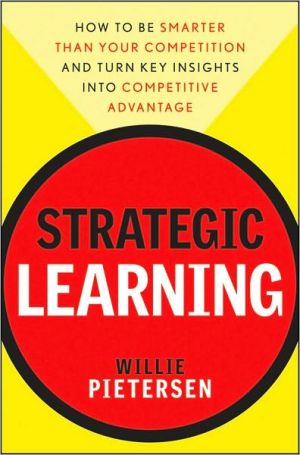The Knowledge Management Toolkit: Orchestrating It, Strategy, and Knowledge Platforms
"The Knowledge Management Toolkit, Second Edition" walks step by step through the development of a state-of-the-art Knowledge Management Platform. Thoroughly revised to reflect the latest technologies and best practices, it offers the most complete, results-driven roadmap for building KM systems that leverage existing infrastructure and knowledge. Utilizing practical checklists and diagrams, Amrit Tiwana introduces advanced techniques for planning, design, development, deployment, and...
Search in google:
The #1 practical knowledge management implementation guide—now completely updated!Incremental, results-driven techniques that build on existing knowledge and infrastructure Covers planning, design, development, deployment, and management Powerful new solutions for measuring the ROI of KM platformsIn The Knowledge Management Toolkit, Second Edition, leading consultant Amrit Tiwana walks step by step through the development of a state-of-the-art enterprise Knowledge Management Platform. Thoroughly revised to reflect today's latest tools, technologies, and best practices, this hands-on guide offers a complete roadmap for building KM systems incrementally?with each step delivering new business value, and seamlessly building on the work that preceded it. Utilizing practical checklists and diagrams, Dr. Tiwana introduces today's best techniques for planning, design, development, deployment, and management, demonstrating exactly how to: Identify the knowledge most crucial to your business Align business strategy and knowledge management Leverage existing infrastructure Transition from managing data to knowledge Focus on process, and on tacit?not just explicit?knowledge Architect a future-proof, adaptable KM platform Build and deploy KM systems using the proven Results Driven Incrementalism (RDI) methodology Implement leadership and reward structures that make KM work Rigorously calculate ROI on KM systemsAmong this edition's many new features: a thoroughly rewritten chapter on strategy; powerful new "real-options" methods for assessing ROI; in-depth discussions of knowledge platforms and digitalpeer-to-peer networks; many new case studies; and much more. CD-ROM INCLUDEDThe accompanying CD-ROM contains Tiwana's interactive, unrestricted KM Toolkit, plus an extensive bibliographic database of recent KM research, a complete working Web-based KM system, bonus appendices, and reusable copies of all of the book's figures.
Preface\ Real knowledge is to know the extent of one's ignorance.\ —Confucius\ The Knowledge Management Toolkit provides a strategic road map for implementing knowledge management (KM) in your company. This book rests on two assumptions. First, that there is no silver bullet. Second, the value of a business's knowledge is determined by its masterful application. Features in This Edition\ Following the popularity of the first edition, this edition has an entirely rewritten chapter on strategy; real-options analyses have been added for KM evaluation; the notion of knowledge platforms is pervasively emphasized; the role of digital peer-to-peer networks is discussed; several new cases have been added; and the distinction between knowledge integration and transfer runs deep. Several other features of this edition are noteworthy. For starters, all figures are made electronically available on the CD-ROM. In addition, the entire appendix, including the entire KM assessment kit, is now digitized on the CD-ROM. The entire bibliography is also provided in electronic form. How to Use This Book\ In spite of the hyperlinked, web-like world we live in, I highly recommend that you go against that notion and read this book in a linear fashion: Begin with Chapter 1 and continue through Chapter 4. Once you reach Chapter 4, if you have a strong reason to jump to any other chapter, do so. Chapters 5 through 14 make the most sense if you read them after you've read Chapter 4. The reason for this recommendation is simple: Each of Chapters 5 through 14 represent one step of the 10-step road map introduced in Chapter 4. The 10-step road mapappears at the beginning of each of Chapters 5 through 14, with details of the current step highlighted in the respective chapters. Every chapter except Chapter 1 ends with a "lessons learned" section that summarizes the key points covered in that chapter. This might be useful as a checklist when this book is not gathering dust on your bookshelf.\ Many of the software tools mentioned in the book are included on the companion CD-ROM. Most, though not all, tools on the CD-ROM have feature restrictions of some type. They are not here to give you entire software suites to help you cut down the expense of building a KM system or to charge you an extra ten dollars for a CD-ROM that cost only twenty cents to produce. These tools are here because I believe that they add value and help you make sense by seeing the technologies that we talk about in the pages that follow. How This Book Is Organized\ Table P-1 summarizes the organization of this book. An additional table in Chapter 4 (Table 4-1) leads you through the individual phases and steps of the KM road map. The techniques described in this book need not always be applied across the organization; they can be applied at the level of communities, business units, or departments.\ Table P-1How This Book Is Organized\ \ \ Chapter\ What Is Covered\ \ \ \ Part I: Introduction\ \ \ Chapter 1\ Introduction, KM's value proposition.\ \ \ \ Chapter 2\ Imperatives for KM, its need, potential business benefits of KM.\ \ \ \ Chapter 3\ How to make the transition from IM to KM, topologies of knowledge, differences between IT tools and KM tools, why KM is difficult to implement.\ \ \ Part II: The Road Ahead\ \ \ Chapter 4\ The 10-step roadmap for implementing KM in your company.\ \ \ \ \ \ Part IIa: Leveraging Your Existing Infrastructure\ \ \ Chapter 5\ How to build a knowledge platform based on your existing IT infrastructure.\ \ \ Chapter 6\ How to align business strategy and KM in your company.\ \ \ Part IIb: The Second Phase: KM System Analysis, Design, and Development\ \ \ Chapter 7\ How to lay the infrastructural foundations of your company's knowledge platform, choose the collaborative platform, the seven layers of the KM architecture.\ \ \ Chapter 8\ Audit, analyze, and identify existing knowledge assets in your company.\ \ \ Chapter 9\ How to design a right-sized and well-balanced KM team.\ \ \ Chapter 10\ How to create a KM blueprint customized for your company and robust enough to be "future-proof."\ \ \ Chapter 11\ How to develop the KM system, understand how it can be integrated with existing technology standards.\ \ \ Part IIc: Deployment\ \ \ Chapter 12\ How to deploy the system using the results-driven incrementalism (RDI) methodology, select pilot projects, maximize payoffs, and avoid common pitfalls.\ \ \ Chapter 13\ Understand the reward structures, cultural change, and leadership needed for making KM successful; in your company, decide whether you need a CKO or equivalent manager.\ \ \ Part IId: REal-Options Evaluation\ \ \ Chapter 14\ Decide which metric(s) to use for KM in your company—real-option analyses, balanced scorecards, quality function deployment, Tobin's q—and how to use it, arrive at lean metrics that help you calculate ROI on your KM project.\ \ \ PART III: SIDE ROADS: APPENDICES\ \ \ Appendix A\ The KM assessment kit and CD-ROM forms.\ \ \ Appendix B\ Alternative schemes for structuring the front end.\ \ \ Appendix C\ Software tools.\ \ \ Assumptions About Your Company\ There are certain assumptions that I make about you as a reader of this book. I would hope that most, if not all, of these are true if this book (which is written with these assumptions about you as a reader in mind) is to help you and your company with implementing knowledge management.What This Book Is Not About\ Let me first explain what this book is not about and what it is that distinguishes this book's approach. This book is:\ \ Not about trends: Forget trends and forecasts about how businesses are disintermediated, organic, flattened, and T-shaped. This book is not about trends. Predictions, as all research, weather forecasts, and stock markets suggest, is rarely an accurate predictor of the future. What you'll learn in this book will probably still apply when organizations supposedly become X-shaped, intermediated, or inorganic. Rather than being a trend in itself, this book will help you benefit from those trends.\ Not about new vocabulary: This book is not out to invent new buzzwords. Buzzwords come and go; KM is here to stay.\ Not about the silver bullet: This book is not the silver bullet for KM and does not claim to be one. It is not about trademarked methodologies that promise the world but scarcely deliver a village.\ Not about analogies: Analogies can sometimes be helpful but can also be very misleading. Analogies are an effective way of communicating strategies, but a very hazardous way of analyzing them. Remember that the road map is not a "shrink-wrapped" methodology. Nowhere in the following pages will you find a discussion about how KM is like ecology, bungee jumping, war, or making love. The same holds true of the cases discussed in this book. Cases are instances of strategies, not strategies themselves.\ Not about my opinion: Opinions can be wrong. This book is built on lessons learned from years of cumulative research spanning several countries and hundreds of companies, big and small, in diverse industries. Wherever there is an opinion, I'll tell you it's an opinion, and that opinion is not necessarily a fact.\ \ Think of this book as a conversation between you and me. I would love to hear your comments, suggestions, questions, criticisms, and reactions. Feel free to e-mail me at Amrit_Tiwana@bus.emory.edu\ Amrit Tiwana\ Atlanta
PrefaceAcknowledgmentsAbout the AuthorPt. IThe Rubber Meets the RoadCh. 1Introduction3Ch. 2The Knowledge Edge13Ch. 3The Origins of Knowledge35Pt. IIThe Road Ahead: Implementing Knowledge ManagementCh. 4The 10-Step Knowledge Management Road Map67Pt. IIAThe First Phase: Infrastructure Evaluation and LeverageCh. 5The Leveraged Infrastructure77Ch. 6Aligning Knowledge Management and Business Strategy89Pt. IIBThe Second Phase: KM System Analysis, Design, and DevelopmentCh. 7The Knowledge Management Platform125Ch. 8Knowledge Audit and Analysis171Ch. 9Designing the Knowledge Management Team199Ch. 10Creating the Knowledge Management System Blueprint219Ch. 11Developing the Knowledge Management System247Pt. IICThe Third Phase: DeploymentCh. 12Prototyping and Deployment267Ch. 13Leadership and Reward Structures289Pt. IIDThe Final Phase and Beyond: Real Options Analysis for PerformanceCh. 14Real-Options Analysis for Knowledge Valuation303Pt. IIISide Roads: Appendices (On the CD-ROM)Digital App. AThe Knowledge Management Assessment Kit335Digital App. BAlternative Schemes for Structuring the Knowledge Management Platform Front End341Digital App. C: Software Tools343Endnotes345Bibliographic References and Further Reading359Glossary369Index373About the CD388








